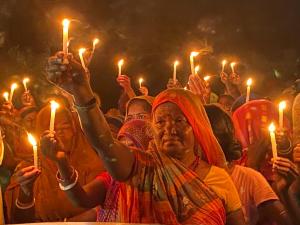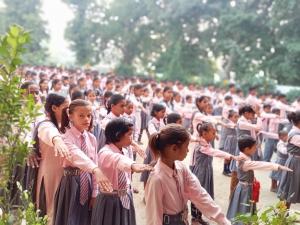India must accelerate progress in high-risk communities to prevent tens of millions more girls entering illegal child marriages by 2030
Today, more than 45,000 villages in 300+ districts with a high prevalence of child marriage are raising their voices to demand an end to child marriage on the first anniversary of the Child Marriage Free India campaign. This is a six fold increase in the number of villages which initially joined the campaign in 2022, with girls, women, and grassroots actors leading the charge.
Child Marriage Free India is mobilising across the nation to demonstrate that communities do not want their daughters to be married as children, and to galvanise action among state actors to deliver quality public services for girls and families, and to implement the rule of law.
Priyanka Sinha is Head of the NGO, Chotanagpur Kalyan Niketan, in Simdega, one of the worst affected districts in Jharkhand. Married as a child, she now works to stop other girls being forced to marry. “Getting married off as a minor changed my life forever but couldn’t change my destiny. When I got married I was just 15 and as a child I had no understanding about the concept of marriage. At the time of marriage, I thought we are going for a picnic with my family and will return in the evening. My husband is 12 years older than me. As a child bride I have suffered domestic violence by my in-laws and my husband. The torture of that time lasted till the birth of my third child. After this, I gathered the courage and, with the support of my children, I pursued education and founded, ‘Chotanagpur Kalyan Niketan,’ in Simdega, Jharkhand. My aim is to ensure that no girl faces the kind of ordeal I faced due to child marriage. I will keep on fighting this evil practice and sensitise people through my organisation.”
Since 2006, India’s child marriage rate has more than halved, from 47.4% of women aged 20-24 who were married as children in 2005-2006, to 23.3% in 2019-2021 (Ministry of Health and Family Welfare, National Family Health Survey (NFHS-5) 2019-21). Yet the picture at the district level is wildly varied, ranging from 1% in Thrissur, Kerala, to an unbelievable 57.6% in Purba Medinipur, West Bengal. Of the top 20 districts in India with the highest prevalence of child marriage, 16 are in West Bengal and Bihar. Child Marriage Free India is working to accelerate the reduction in child marriage by targeting 257 high-prevalence districts, to achieve a rate of 10% by 2025, and the elimination of child marriage in India by 2030.
In these districts, women and girl campaign leaders are working with the Child Marriage Free India campaign, a coalition of 160 NGOs, to raise awareness among communities of the impact of child marriage on children’s lives, as well as to support girls to prevent their own child marriages.
Just a few days ago, the blueprint to end child marriage in India, written by noted child rights activist and lawyer Bhuwan Ribhu, was unveiled across 235 districts by child marriage survivors. This framework has mapped out a strategy for the Child Marriage Free India campaign and since the start of the campaign 1,700 child marriages have been stopped.
Anjali Kochar, Executive Director of the Kailash Satyarthi Children’s Foundation US which is supporting more than 160 NGOs across India combatting child marriage, said, “The Child Marriage Free India campaign is tackling the problem from the ground up, and from the top down: it advocates at the national level for stronger public services and implementation of the rule of law, but critically our partners on the ground are working with the communities where there remains an extremely high prevalence of child marriage. Child marriage will end, when communities, state actors, and NGOs work together.”
Advocacy and training also play a critical role in the campaign, particularly to ensure child protection laws and practices are implemented. 18 state governments and Railway Protection force organised events today to join the campaign and take the pledge against child marriage. From police stations to courtrooms, panchayats and community centres, from children to grandmothers who are survivors of child marriage, millions of people are calling for a child marriage free India.
India has some of the world’s strongest laws against child marriage and child sexual abuse - which means that sex with a child spouse is rape. But laws are ineffectively implemented, and child marriage occurs in environments which are enabled by cultural acceptance and an infrastructure which physically allows child marriages to take place, from religious leaders to wedding suppliers. However, child marriage will never end in India without addressing its root causes of poverty and lack of access to public services including education, especially for girls. Child Marriage Free India is calling for access to 12 years of quality education for girls, for social protection for families to support their daughters to complete their education, and for the government to effectively implement its laws against child marriage.
Paroma Bhattacharya
India For Children
+91 85959 50819
email us here






